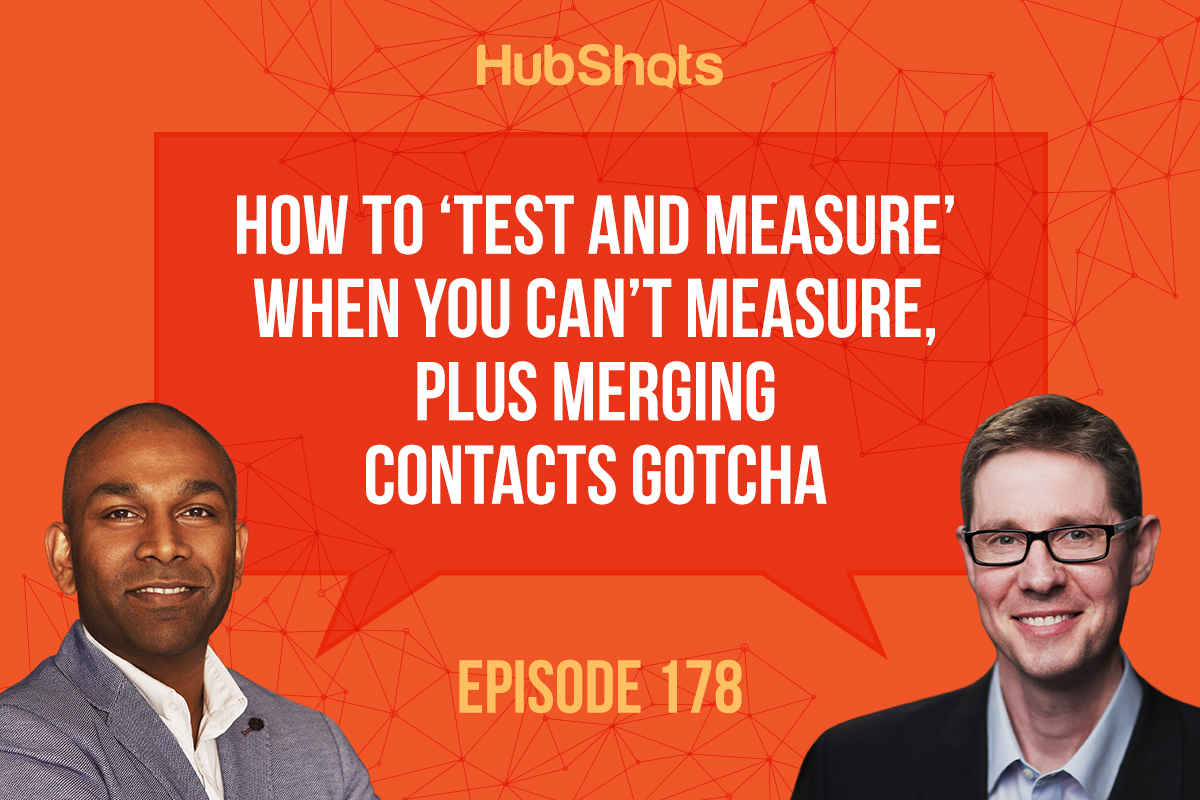Episode 251: The Psychology of A/B Test and Measure
Welcome to HubShots Episode 251: The Psychology of A/B Test and Measure This edition we dive into:
If you're new to HubSpot, we guide you on where to start, how to do it right, and train you to make the most of the platform.
Review your HubSpot portal to uncover issues, spot growth opportunities, and ensure you're maximising its potential.
Unlock business growth with automation and attribution. Implement best practices and execute marketing campaigns.
HubSpot On-Demand
HubSpot Training
HubSpot Websites
HubSpot Campaigns
HubSpot Optimisation
HubShots - APAC's number 1 HubSpot focussed podcast - where we discuss HubSpot tips & tricks, new features, and strategies for growing your marketing results.
This episode we chat about how to avoid a gotcha when merging contacts, plus think through how to ‘test and measure’ video engagement.
Listen to the episode here: https://soundcloud.com/hubshots/178-how-to-test-and-measure-when-you-cant-measure-plus-merging-contacts-gotcha/
HubShots, the podcast for marketing managers and sales professionals who use HubSpot, hosted by Ian Jacob from Search & Be Found and Craig Bailey from XEN Systems.
Subscribe to our YouTube channel here: https://www.youtube.com/channel/UCD3Uo4X-IxPJLE8ygPDQhNQ
Subscribe to our Spotify channel here: https://open.spotify.com/show/7oee8w41riN5aRNrLKT2ar
Join the Facebook group here: https://www.facebook.com/groups/hubshots/
Follow us on Twitter here: https://twitter.com/hubshots
Follow us on Instagram here: https://www.instagram.com/hubshotspodcast/
Follow us on LinkedIn here: https://www.linkedin.com/company/hubshots/
Recorded: Wednesday 23 October 2019 | Published: Friday 1 November 2019
Our strategy for the podcast
Using it mainly as a bottom of the funnel marketing piece.
We use it to drive perception and credibility.
Example scenario: you change your company domain and everyone’s email address changes
How do you update your HubSpot login to use the new address?
Go to your profile, there is a button to change your email address and follow the verification steps as outlined here > https://knowledge.hubspot.com/account/how-do-i-change-the-email-address-of-a-user
<h2">Shot 3: HubSpot Sales Feature of the Week
</h2">
https://blog.hubspot.com/customers/territory-division-and-lead-rotation-in-hubspot-workflows
Thanks Kyle!
A good example of using workflows to help with sales processes
Be aware that merging contacts can re-trigger workflows for the destination contact
https://knowledge.hubspot.com/contacts/how-do-i-merge-contacts
https://knowledge.hubspot.com/contacts/deduplication-of-contacts-companies-deals-tickets
You may have started getting email notifications from HubSpot telling you about contacts you can merge. This is good for data cleanliness, but can be a gotcha, which I don’t think HubSpot does a good job of warning people about.
How to handle this: Have exclusions lists in your workflows
Have a process for handling this - the best way to manage it is to have Global Suppression Lists setup which are set in all workflows. Add all the contacts you are going to merge into the Global Suppression list before your merge, and then take them out after the merge.
Listen to Shot 2 back in episode 149 for more details on how we implement this:
https://www.hubshots.com/episodes/episode-149
No more mixed http and https content messages - Chrome will block http content
https://security.googleblog.com/2019/10/no-more-mixed-messages-about-https_3.html
However, Chrome is going to do it as intelligently as possible - and will autoupgrade items (eg images) to use their https version if it is available. If not, it will simply block it.
Action item: Check your sites for http items and update to https
How do you ‘test and measure’ if you can’t be confident in the measurements?
Take Facebooks overestimation of video views debacle:
https://www.theverge.com/2018/10/17/17989712/facebook-inaccurate-video-metrics-inflation-lawsuit
https://www.bbc.com/news/technology-45901287
Summary of the issue: how they calculated time spent watching (total time divided by ‘view’ instead of total time divided by ‘started watching’)
Eg if total time watched is 3 mins, and 3 people start watching, but only 1 actually views for more than 3 seconds, then there is a big difference
By one calc the average watch time is 3 mins, with the other it is 1 min, ie a 300% difference
The key is to push your measurement to be more than just engagement - aim to get visits and conversions as well
It’s also a reminder that using multiple analytics packages is fine - they won’t agree exactly, but they should be within 10% of each other. Eg using both HubSpot analytics and Google analytics on your site.
Here’s an example of bad marketing practices:
https://twitter.com/_loganmcdonald/status/1185992782999162880
Business Casual by Morning Brew
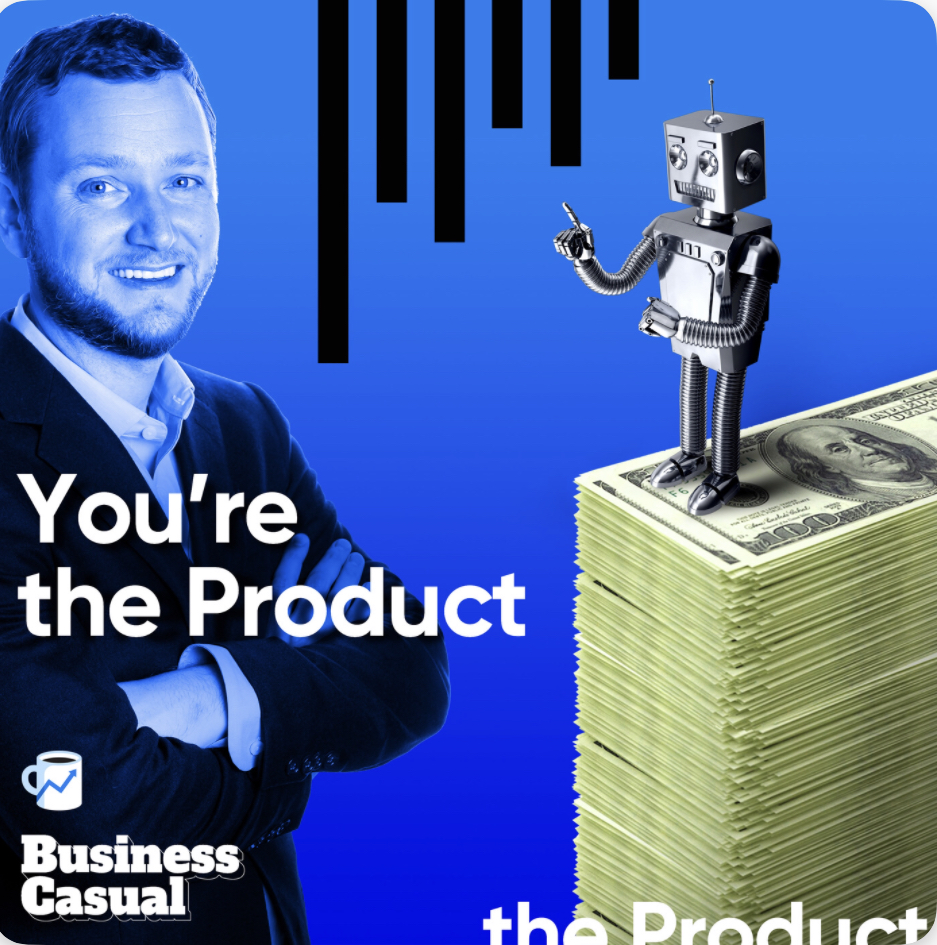
Question: Is it a problem if my page has multiple H1 tags.
Answer: No
John Mueller gives a few pointers:
https://www.youtube.com/watch?v=zyqJJXWk0gk
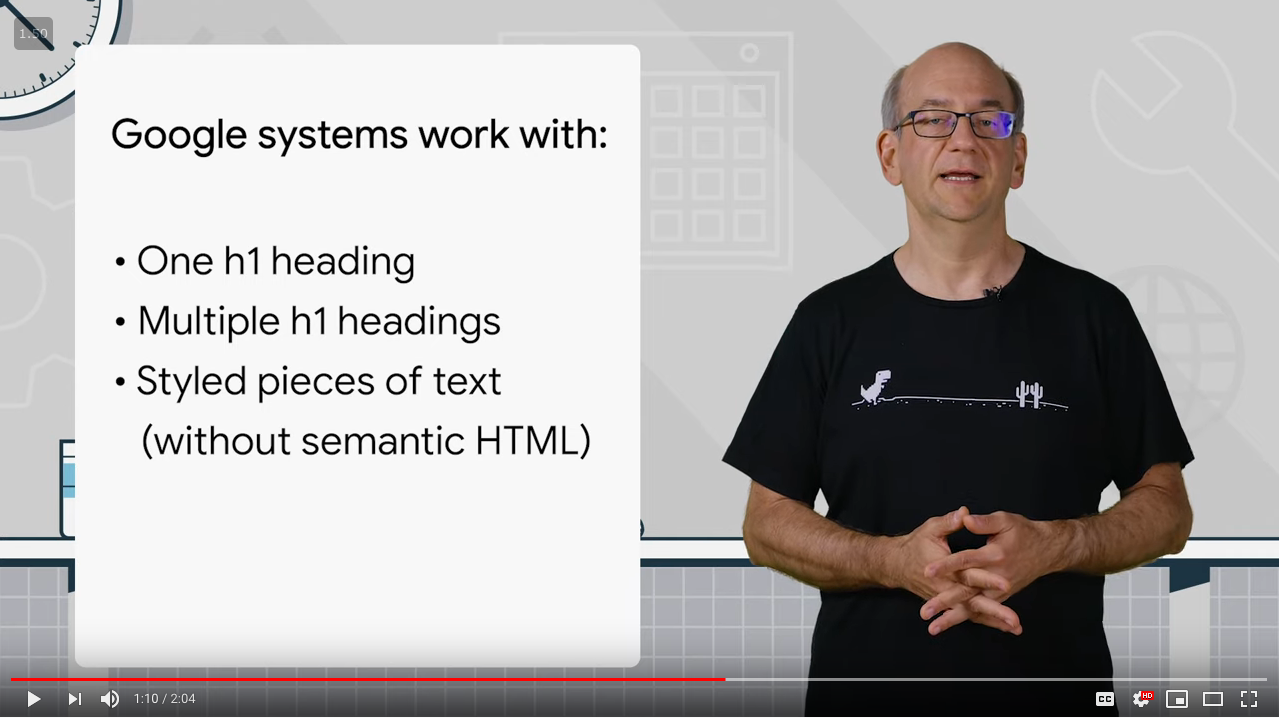
“Dressing well is a form of good manners.”
From Clare Sheng’s wonderful book: The Suit Book
Google Search Console has a few new reports related to video (if you use markup with your videos):
https://webmasters.googleblog.com/2019/10/search-console-video-results-reports.html
Ahrefs is building a search engine with a 90/10 revenue sharing model
Please rate and leave us some feedback as this helps us improve and reach more marketers.
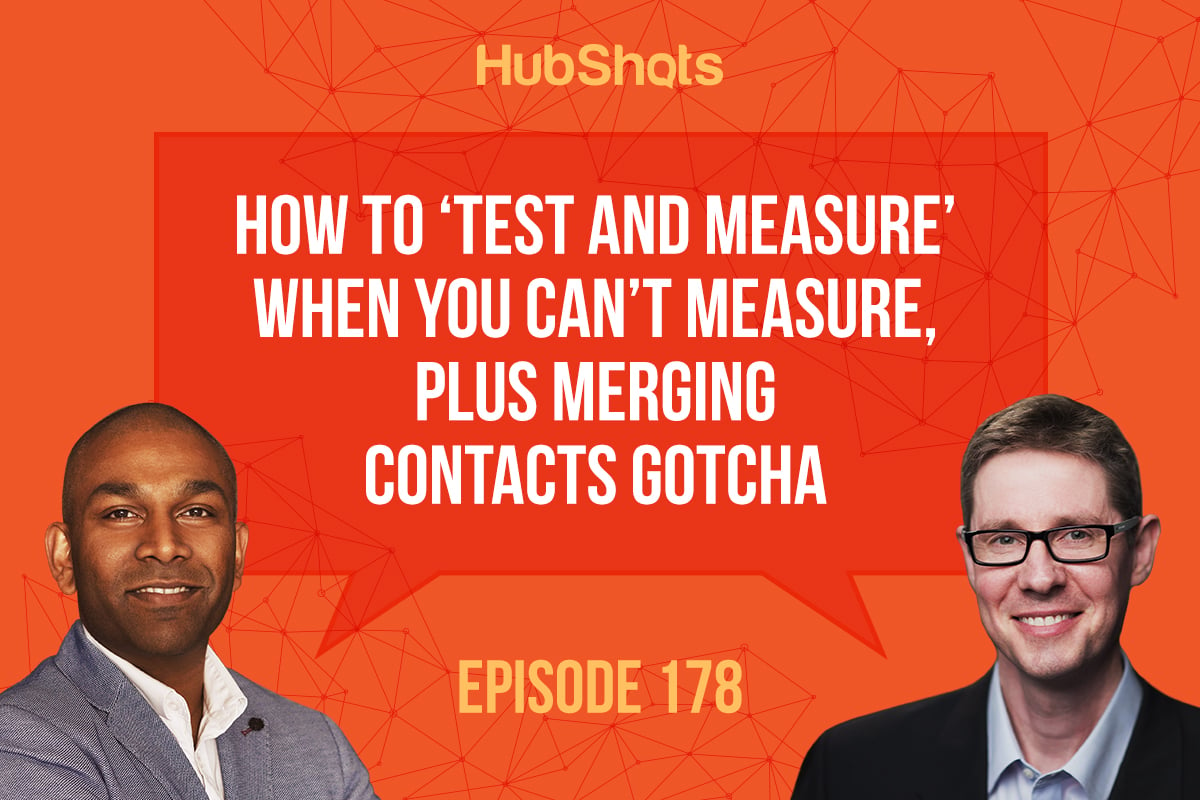
- [Ian] Hi everyone, welcome to HubShots episode 178. In this episode, we look at how to test and measure when you can't measure plus merging contacts, gotcha in HubSpot. You're listening to Asia Pacific's number one HubSpot-focused podcast, where we discuss HubSpot tips, tricks, features and strategies for growing your marketing and sales results. My name is Ian Jacob from Search & Be Found and with me is Craig Bailey from XEN Systems. How are you, Craig?
- [Craig] Really good and you know what's unusual about this episode? We're actually recording this during daylight hours.
- I know.
- For once. So you came over, we had lunch together--
- [Ian] That's right.
- [Craig] and it's about four o'clock in the afternoon.
- [Ian] It's a cracker of a day outside, I have to say.
- [Craig] It's so good, but yeah, there's light, it's light as we record. Normally, we're recording late at night so this is a bit of a treat for us.
- [Ian] Onto our growth strategy for the week, Craig, or our growth thought for the week.
- [Craig] Yeah, well, this is something that I've said a couple of episodes. We're gonna chat about our approach to the podcast because this has came up at the HubSpot user group back in September and we're just gonna mention our approach and this might be useful to listeners because we actually don't use the podcast as a top of the funnel base, which people might think is weird. Aren't you trying to get new listeners? Aren't you trying to grow your audience? Of course everyone wants that and we do want that. And as our listenership grows, that's great. But once you know the key criteria, actually what we use it for or I'll talk about it myself, you can chat maybe a little bit different, but it's a credibility piece. So, for me and our agency, it's very much bottom of the funnel. It's about showing our expertise. It's also about our credibility. And so, rather than generating leads from the podcast, it's more about when we get a prospect, we're chatting with them, they look to the podcast to get confidence in us. So, it's more of a closer. It's actually more of a sales tool at the end than a marketing tool at the top. How do you feel? Is that similar for you?
- [Ian] It has been very similar for me, Craig, and even more so probably for this year, I would say that's been a big part of it. So, I think I am trying to with some of the stuff we're doing internally in our business and like we've been doing for ourselves is try to drive more of that to the top of the funnel, so to get people interested.
- [Craig] And here's the thing. A lot of our work just comes through referral. So, the question for, well, other agencies and small businesses is if you're getting a lot of work through referrals, should you actually be spending time at the top of the funnel awareness and all these kind of bigger company play books? And well, no, not really. Why would you spend money and time and effort focusing on completely new audiences, if you're getting referral, right? That makes sense for small business. But as you grow, of course, referral kind of plateaus and you do need to move more to and inbound marketing piece and much more top of the funnel. So, we will be pushing that as we're growing and I think that's probably our 2020 goal. We'll be doing a lot more of that. Pushing the podcast out there, a bit more awareness. But anyway, I just thought that was, perhaps, interesting for our listeners and marketers in general. It's always about thinking what's the goal for each piece of content and the strategy behind it. Anyway, just an insight into ours.
- [Ian] All right, Craig, onto our HubSpot Marketing feature of the week. And this is about how to change your email in HubSpot. Now, why I'm gonna highlight this is I had a customer of ours that has moved their email from a dot com domain to a dot com dot au or vice versa and they wanted to know well, how do I change this? Now, in previous times, I would've gone oh, you need to create a new user for yourself, go through the whole process, then reassign all the contacts to yourself. Anyway, you don't need to do that. You go to your profile preferences. You can actually edit your email address that's associated to your account and then you have to go through the reverification process again, but it means that now you don't have to go through all that malarkey that you used to do before. So, there you go.
- [Craig] Who would've thought it was that simple, eh?
- [Ian] I know.
- [Craig] Just go to your profile and update it.
- [Ian] Thank you to HubSpot Support for pointing that out to us.
- [Craig] By the way, I was listening when you had that HubSpot 'cause you called them, right?
- That's right.
- And, well, apart from some interesting on hold music.
- [Ian] I know that, the on hold music, I don't know about the on hold music.
- [Craig] Worth calling 'em just to listen to that, my goodness. But anyway, it's super helpful. I'm sure we have, but have we ever had a bad support experience? Gee, they're good.
- [Ian] I think about this is the marketing and growth thought of the week. That's one thing that they've nailed, support. All right, onto our HotSpot sales feature of the week Craig. Territory rotation with work flows. Shout out to Kyle for this blog post
- Jepson.
- Yep. They've been pushing a lot on round work flows and you know how we love work flows.
- I know.
- I love work flows.
- [Ian] I read this when I got the email notification. It was actually really good.
- [Craig] I think the message from this more generally is you can do anything with work flows. That's where we're getting to the point where when someone has a question how do I do this? It's not a standard feature. It's like, well, my go-to is I'm pretty sure we can work out how to do that in a work flow. So, this is a good article in this. In this case, territories and assigning them, rotation. So a good post so just go through and get an insight into that.
- [Ian] All right, onto the HubSpot gotcha of the week Craig and this has to do with the side effects of merging contacts. Now, I'm liking this feature in HubSpot, right? And been getting notifications and my customers are getting confused. They're like what is this merging contacts stuff? Anyway, we're gonna tell you that there is a gotcha to this that would happen, especially if you're running work flows on the backend that rely on contact properties. There are things that get triggered when you merge work flows. So, tell us more, Craig.
- [Craig] Well, I almost wanna say with work flows after just talking about how awesome they are, as we do every episode, it's kind of like with great power comes great responsibility, so to speak. Work flows, they can be very powerful but they can also have gotchas like this. Now, we actually mentioned this way back I think at the start of the year in episode 149.
- [Ian] Yes, we did.
- [Craig] Where we talked about merging contacts. and basically this side effect that many people I don't think are aware of. And what it is, let's say you've got contact A and you're gonna merge it into contact B. Now contact B, let's say they signed up on the site, they filled in a form and then it sent some thank you emails, put them in a nurture, right? Let's say they did that a year ago, so that's contact B and that's the one you're merging into. Now contact A might just be a variation of their email address and you happen to notice it because you get one of those nice notifications from HubSpot, thanks for sending those out. So you go along, you go right, I'll just put HubSpot contact A into B, so you merge it. Bang, suddenly all those work flows that contact B has already been through get triggered again for contact A. And so, this can be quite puzzling, quite distressing for clients, as well. It's like right, well, how did this happen? Well, here's the side effect. And you know what? A slight criticism of HubSpot for this 'cause even though they've got a support article that talks about potential downsides and we've got that linked in the show notes. When they send these emails out saying you've got all these contacts to merge and they have that list, they don't make it clear. There might be a little message, you know, oh be aware that there could be these effects, but I actually think this is a big gotcha and it's causing confusion for clients and I think it's gonna be a big problem that HubSpot's got on their hands. Anyway, how do you get around it? Which, of course, is the key. Now, we've got a bit of a workaround and we went through this back in episode 149 and it involves creating exclusion lists. And one of the things you might know in work flows, is you can have exclusion lists or suppression lists that basically if someone is in one of these exclusion lists they don't go through the work flow. And we have this process with the clients. We have this whole process where if we're gonna merge contacts, we put those contacts into an exclusion list so that they don't get triggered into work flows. Or if they do, they're just excluded from work flow. We put the into those exclusion lists, we then merge the contacts and then we take those contacts out of the exclusion lists. Well, the resulting, finalized contact list. And that's the way you get around it, so it's quite manual. You actually have to go through all your contacts and put them in these exclusions lists, then remember to take them out in order to stop this side effect of the work flows. Now, that's the workaround at the moment. I hope HubSpot comes up with a better kind of option. For example, what I'd love is just when you merge and option that says do not trigger any work flows. As simple as that. That's really what they need. I think they'll bring that out 'cause I think there's gonna be a problem for clients.
- Yes.
- Anyway, that's the gotcha and that's the workaround at the moment. Find us in episode 149 shot to for more details on that.
- [Ian] Excellent. Now onto our marketing tip of the week, Craig. No more mixed http and https content messages and Chrome will block http content. So this, listeners, is sites that haven't been transitioned to a secure... have a security certificate and are secure. And within that, there's obviously images and other assets that get caught, so previously people might've know of this as mixed content warnings where the site might actually be secure but it's calling as if it's on an insecure server. And what Chrome does is it basically highlights to you and says oh this is unsafe. Do you wanna proceed, right? So, what have they done, Craig?
- [Craig] Well, this is in an upcoming release. What they're going to do is instead of just giving warnings they're just gonna block that resource. Your page loads and let's say there's an insecure http resource--
- Yeah, like an image, yeah.
- They just won't show it. It'll just be kind of rendered out, yeah.
- [Ian] Rendered out, yeah.
- [Craig] Yeah, so that there's no chance.
- [Ian] so, I mean, this is really interesting. I'll tell you why. Because people that haven't gone through the due diligence and the process of upgrading to a secure site properly are gonna have this problem. Like I'm only telling you this because we have gone through a process with customers over the last few years where we've actually gone through, checked all the mixed content warnings, made sure that everything's being called correctly. And then there are are other people that we've dealt with who are just like oh, no, don't worry, just apply the certificate, don't worry about it. It'll all be good. These are the people that are gonna suffer very soon when it comes to these--
- [Craig] Yeah, look and I think it depends on the hosting and also plugins, like in WordPress you can get plugins that force all the resources. One of the things I will say about this upcoming chrome release is that they're gonna be smart about it. So, they're going to, let's say it's just an http image, so non secure, they will check the https version and if it's there, that'll load that instead. So, it's doing some smarts in the background. Thanks Chrome, that's actually a good thing. But, if they can't find the secure, bang, they're just gonna leave it out.
- [Ian] First thing, make sure you've got a security certificate. Second, once you've done that check for mixed content warnings and then go through appropriate remediation to get all of that fixed before this rolls out so you don't get affected. All right, Craig, onto our insight of the week. A little a, what do I call? Our maxim. Test and measure that we always talk about. And thinking of Chris, we just spoke to Chris--
- [Craig] Chris Mottram, our producer who is helping us test and measure to get our audio quality even better. Thanks, Chris.
- [Ian] And this is something that you were telling me over lunch which totally bypassed me, but metrics on videos in Facebook are totally wrong.
- [Craig] That's right. So let me give you a bit of the background to this just quickly because the background's interesting but, I guess, the ramifications of it are even more important. So, this all goes back a couple years to when Facebook was rolling out video and are giving stats on average video view time, but they calculated it incorrectly. And I think this goes back to starting in 2015 and the reason it's came to light is 'cause there was a class action or legal action actually taken against Facebook in 2016 about them incorrectly reporting the stats. Now, just quickly what they had done is in terms of calculating average view time, they were taking all the time that it was viewed and then instead of dividing by the total number of people who might have just started watching. Remember how the videos used to auto play just starting as you were scrolling through? They only divided it by the number of people who were actually called a viewer. So, the kinds of people that watched for at least three seconds or four seconds count as a view. The difference is, if you only divided by that smaller number of people, the average view time looks really high. Whereas if it was divided by actually the number of people that indirectly just started it, then it was must lower. So the point is that their numbers or the metrics were inflated by well, multiples up to, and some people claim 800%, et cetera. So, that's all the background. Now, that all started in 2016. It's all come out now recently because it's part of that ongoing legal action. They've had access to internal Facebook communication. Like hundreds and hundreds of pages of emails and so forth. And it turns out, Facebook knew about this for more than a year before they did anything about it. Even though, they're saying oh sorry, small calculation error. Yeah, we fixed it, minimal effect, right? What's coming out now is that it was massively overestimated or overinflated numbers and they knew about it for ages. They did nothing about it and they didn't bother. It wasn't a concern, right? Okay, so that's the history. What's the ramifications of that? The ramifications are lots of things. First of all, people were moving ad budgets from other platforms onto Facebook because you remember a couple years ago everyone's all like oh video, video is the future, right? And, of course, it is but the numbers on Facebook seemed so good and so cheap, as a result that people were pushing whole budgets away from, say, YouTube and other platforms onto Facebook. And the problem is because the numbers were inflated, they weren't getting the results they expected. Maybe you're expecting similar results to what you get on YouTube but it's not happening on Facebook, et cetera. So, there's been whole, I guess, marketing budgets pushed into a platform or a medium, which has been false. Like, in fact, not only a mistake, but you could actually say deliberately withheld. So, here comes the question 'cause we are always saying test and measure. How do we test and measure if we can't actually measure accurately? If we can't be confident? So that's what I wanna chat about today in this insight. So, but before we go on, I've spoken for a bit there. Did you wanna make any comments about that and maybe some action items from your point of view before I, yeah, go on a bit?
- [Ian] Yes, so I think one of the actions here is we all know that, especially where we work within HubSpot, there's a little bit of leaks in there. We also always put in the Google Analytics so we have a second point of reference. Now, it might not always be exactly 100% because people measure things differently in terms of what's the duration that this measurement takes into account before it actually gets measured, which can be different, so give me your different results. But, regardless to say, there are all these different points or analytics packages that we can use to collect data. So if you're using a particular package to collect data about your videos, then you should be able to tell is the video playback, or the points at which people are dropping off or playing, is it that the same as what's being reported? That's essentially what I wanted to say, so like having a second point of reference.
- [Craig] Actually, you've highlighted one thing, which is you wanna get them off Facebook onto your site in some point. So, one of the keys to coming around this is not only engagement but actually conversion stats, so you get them to your site. So, you might have a Facebook video but the call to action is to get them to your site so that you can actually compare whether it's working. So for all those people who moved away from YouTube to Facebook, there should have been an end result, which was is it actually building audiences that drive people to your website, or to some other conversion action, not just an engagement metric. However, your point around having multiple analytics packages is perfect because there's multiple video platforms. So another, I guess, takeaway from this is don't just choose one channel and solely put all your budget there. You might start with one channel but then you gotta grow it out. So for example, if you're running a number of videos on Facebook, run them on YouTube, run them on LinkedIn, run them on twitter. Run them on various platforms and check across each because if Facebook is looking ridiculously good in terms of engagement, perhaps something's wrong. And this could be any of the other platforms you know, it could be Twitter in the future, it could be LinkedIn, who knows? THey're probably all gonna have problems, but at least by having multiple platforms that you're using you can actually compare and work out some anomalies. But then, the main takeaway is you've gotta get them back to a conversion action. And by conversion action, we're ultimately talking about getting an email address. If you can get that, that's I guess, the goal at the end to compare across the channels.
- [Ian] All right, Craig, on top podcast of the week and this is a business casual podcast from Morning Brew. And Morning Brew is one of the probably of the emails we read every day.
- [Craig] I love this, in terms of a daily email newsletter. We've talked about this before. There's not many I read every day.
- That's right.
- Morning Brew's one of them.
- [Ian] Anyway, they've got a great podcast and they've been interviewing some really interesting people so I would encourage you to listen to it. It just broadens your horizon on the different things people are out there doing and I love it.
- [Craig] Isn't it interesting how these, we'll call them news sites, are moving into other mediums? So, Morning Brew, moving away. Not away, but complimenting an email newsletter, which is what they're famous for, with a podcast. I'm not sure where it was, Netflix maybe the other day, but New York Times, of course, and they have these little video documentaries. I think it's called "15 Minutes." Little stories by the New York Times turning what is a written piece into a video piece. And they're all really good. So yeah, we're seeing this move into other mediums.
- [Ian] All right, now we've got a couple of resources of the week, Craig. Ask Google webmasters, there was a question in there. Is it a problem if my page has multiple hitting one tags? And the answer is--
- The answer's no. This actually came as a surprise to me 'cause as a longtime SEO, it's always been look, just trying to have one H1, hitting one, that's a hitting one, H1. I only have one H1 tag on your site and there still is good reason to do it 'cause Google looks at it as a sign of what this page--
- Hierarchy, right?
- Yeah, hierarchy. But yeah, Google is like no, have as many as you want, that's fine, if it highlights important things, that's good. Use it for readability. So we've got John Muir from Google Little Webmaster Hangout talking about that in the show notes.
- [Ian] Yeah, and listeners if you don't know about John Muir and those hangouts that he does, I encourage you If you're not in your business doing this, share this with the person that is. Because I think there's some really good information in there that you can often use and pick up. And often a lot of myths get dispelled and what we often hear out there in the marketplace. If you listen to the source and go, oh, hang on, that's just rubbish. You don't have to worry about it, right? You don't have to waste your time thinking about it.
- [Craig] Well, look, let me put a caveat on that. 'Cause, you know, I'm always cynical about Google.
- [Ian] Yes.
- [Craig] When they give guidance like this, I'm like yeah, okay, that's fine. But when they give some other guidance, sometimes, I'm like yeah, well, that seems to work well for Google, maybe not for people. Always be running ads on your brand. It's like yeah, okay, so, I don't know if that's the best advice from Google, but yeah.
- [Ian] Anyway, test and measure, I say.
- [Craig] Test and measure.
- [Ian] All right, the quote of the week, Craig.
- [Craig] Okay, so why'd you pick this?
- [Ian] Well, I picked this because you gave me a book. It's called "The Suit Book: Everything "You Need to Know about Wearing a Suit" by Clare Sheng. And one of the quotes in this book was "Dressing well is a form of good manners." And it's from Tom Ford. Now you've read this book and you really liked this book.
- [Craig] I really liked this book and and listeners, I'll just say like I'm your typical nerdy geek, I dress badly... Well badly, I just, I dress comfortably.
- [Ian] Craig, let's put it this way. You dress comfortably and every since I've know you, you have like this, let me say it, you've got five shirts that are all the same. But you probably have more, right?
- [Craig] I have 10 shirts.
- [Ian] 10 shirts that are all the same. He's got 10 T-shirts that are all the same. He's got three pairs of shoes that are all the same. So, if that's any indication--
- [Craig] Look, It's just efficiency. It's easy. I'm not gonna pretend I'm Barack Obama or Zuckerberg, I'm so busy that it solves decisions. It's just like it's easy and it's comfortable, right? So I've been like this anyway. I'm trying to dress better. Can you believe this?
- That's right.
- I'm trying to lift my game.
- It's good, I'm impressed.
- We'll see how it goes.
- [Ian] So far, Craig has gone with a new pair of R.M. Williams. I'm really excited about that.
- [Craig] I'm trying to wear better shoes, better pants, I'm actually getting things tailored now. I don't know. But anyways, we'll see how it goes. Actually, why are we telling the listeners this? I don't know if they need to know this but anyway, this book had an impact. Oh, I know what I was gonna say. 'Cause this book had an impact on me because we were chatting before, ignorance is bliss.
- [Ian] That's exactly right.
- [Craig] After reading this how to dress well, now I'm actually like oh my gosh. I'm badly dressed and I notice it all the time, and so ignorance was bliss when I didn't know. Oh well, I'm trying to improve.
- [Ian] There we go, listeners. Now, there are a couple of bonus links in this show so I encourage you to check it out. What else can I say?
- [Craig] Test and measure.
- [Ian] Test and measure. Well Craig, until next time.
- [Craig] Catch ya later, Ian.
- [Ian] Thank you for listening to this episode of HubShots. For show notes, resources, HubSpot news including practical strategies you can implement, visit us as hubshots.com.
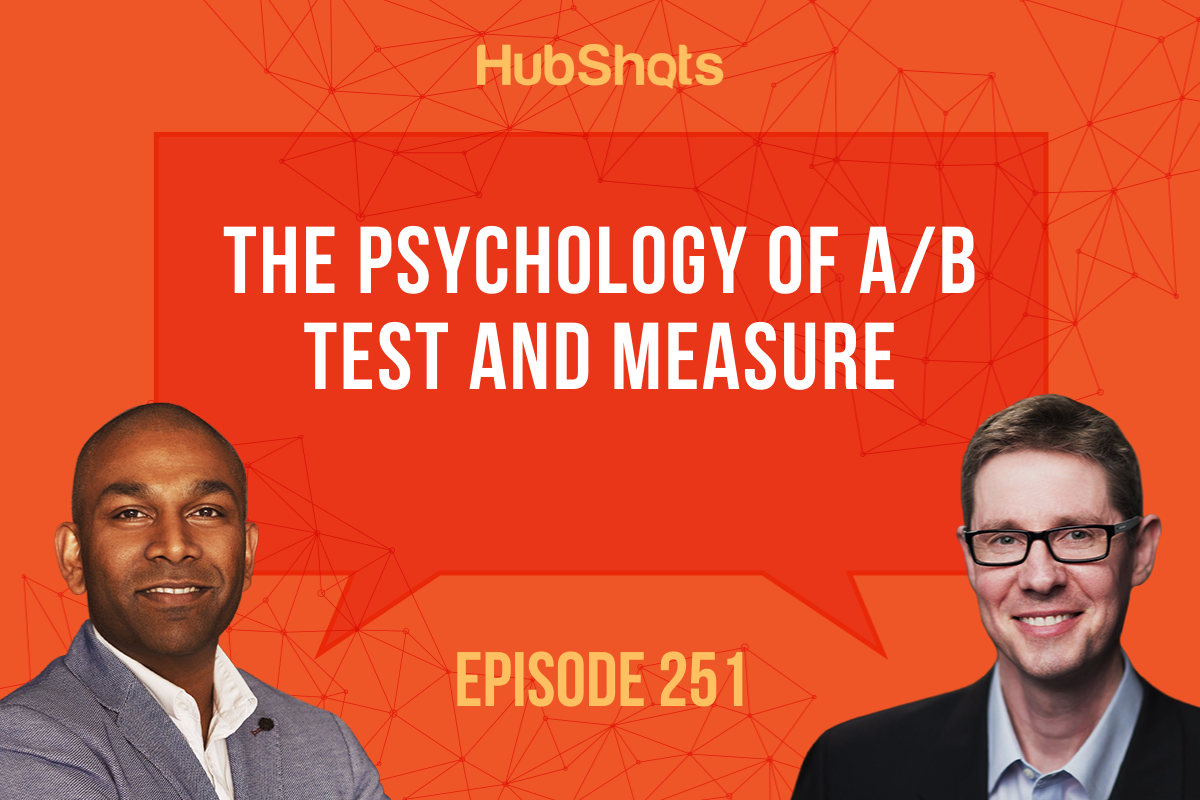
Welcome to HubShots Episode 251: The Psychology of A/B Test and Measure This edition we dive into:
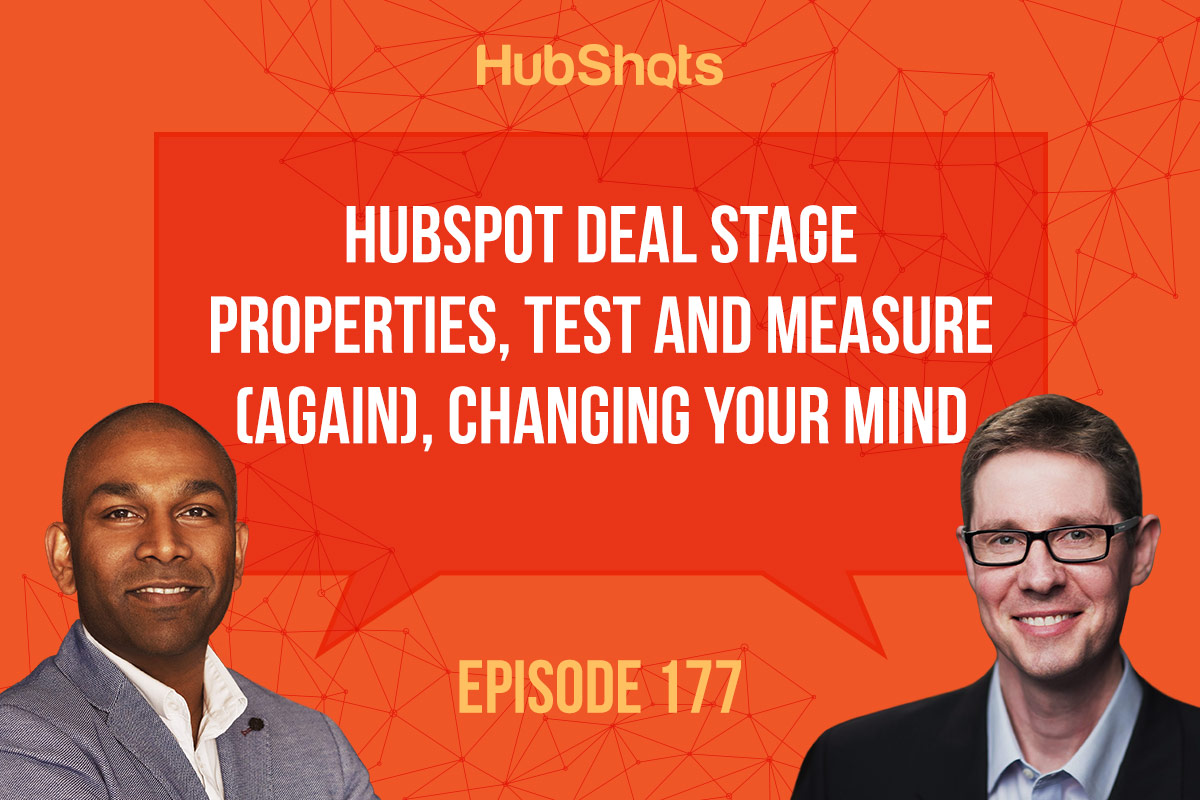
Welcome to Episode 177 of Hubshots! HubShots - APAC's number 1 HubSpot focussed podcast - where we discuss HubSpot tips & tricks, new features, and...
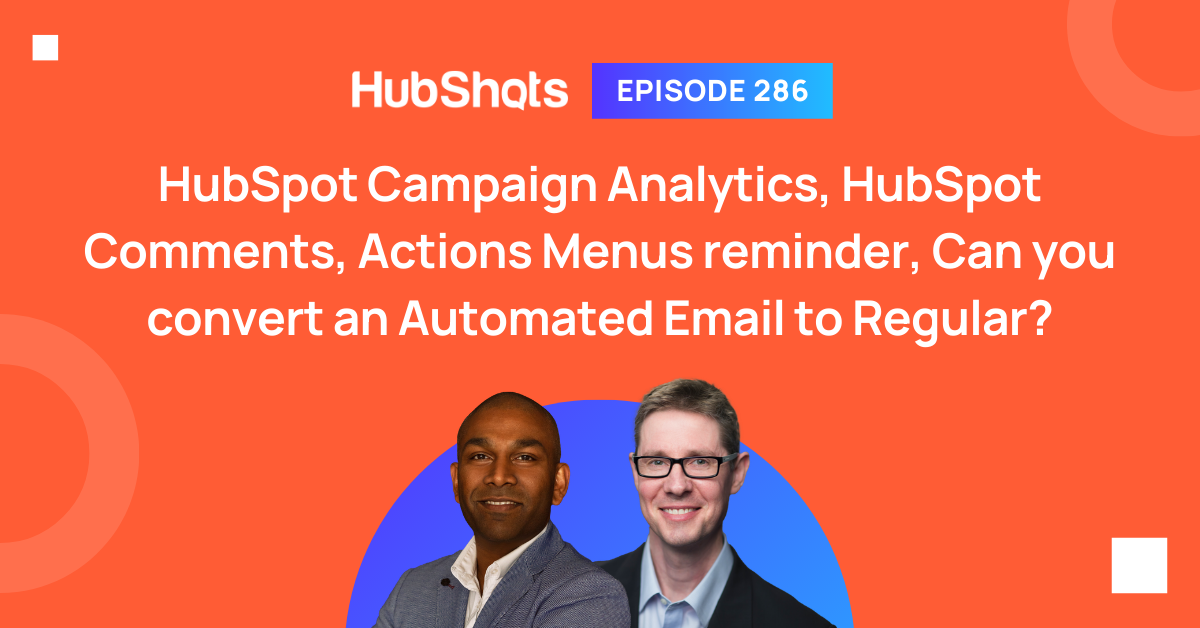
Welcome HubShots Episode 286: HubSpot Campaign Analytics, HubSpot Comments, Actions Menus reminder, Can you convert an Automated Email to Regular? ...
